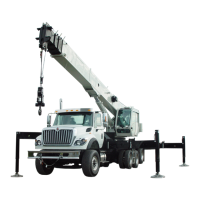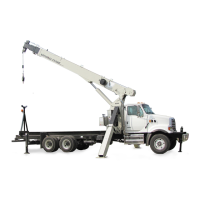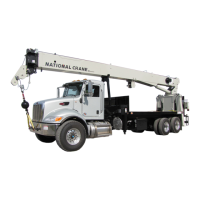SAFETY PRECAUTION - AERIAL LIFT NBT40-1 SERIES OPERATOR MANUAL
3-16
3-29-2018 Control # 610-00
Secure the hook block and other items before moving the
aerial lift.
Stow the outriggers and engage locking pins (if equipped).
Watch clearances when traveling. Do not take a chance of
running into overhead or side obstructions.
When moving in tight quarters, post a signal person to help
guard against collisions or bumping structures.
Before traveling check suitability of proposed route with
regard to aerial lift height, width, and length.
Never back up without the aid of a signal person to verify the
area behind the aerial lift is clear of obstructions and/or
personnel.
On aerial lift equipped with air-operated brakes, do not
attempt to move the aerial lift until brake system air pressure
is at operating level.
Check load limit of bridges. Before traveling across bridges,
ensure they will carry a load greater than the aerial lift’s
weight.
Check state and local restrictions and regulations before
transporting the aerial lift on a road or highway.
Keep lights on, use traffic warning flags and signs, and use
front and rear flag vehicles when necessary. Check state and
local restrictions and regulations.
Always drive the aerial lift carefully obeying speed limits and
highway regulations.
Stay alert at the controls.
If equipped, ensure that the hoist access platform hand rail
and step are in the travel configuration.
Slopes:
- Refer to the Operation Section for more detailed
information on traveling on slopes.
- Driving across a slope is dangerous, as unexpected
changes in slope can cause tip over. Ascend or
descend slopes slowly and with caution.
- When operating on a downhill slope, reduce travel
speed and downshift to a low gear to permit
compression braking by the engine and aid the
application of the service brakes.
COLD WEATHER OPERATION
Cold weather operation requires additional caution on the
part of the operator.
Check operating procedures in this manual for cold weather
starting.
Don’t touch metal surfaces that could freeze you to them.
Clean the aerial lift of all ice and snow.
Allow ample time for hydraulic oil to warm up.
In freezing weather, park the aerial lift in an area where it
cannot become frozen to the ground. The drive line can be
damaged when attempting to free a frozen aerial lift.
If applicable to your aerial lift, frequently check all air tanks
for water in freezing weather.
Never store flammable materials on the aerial lift.
National Crane recommends use of cold weather starting
aids that are provided on your aerial lift. The use of aerosol
spray or other types of starting fluids is prohibited.
TEMPERATURE EFFECTS ON HYDRAULIC
CYLINDERS
Hydraulic oil expands when heated and contracts when
cooled. This is a natural phenomena that happens to all
liquids. The coefficient of expansion for API Group 1
hydraulic oil is approximately 0.00077 cubic centimeters per
cubic centimeter of volume for 1°C of temperature change
(0.00043 cubic inches per cubic inch of volume for 1°F of
temperature change). Thermal contraction will allow a
cylinder to retract as the hydraulic fluid which is trapped
in the cylinder cools.
The change in the length of a cylinder is proportional to the
extended length of the cylinder and to the change in
temperature of the oil in the cylinder. For example, a cylinder
extended 7.6 m (25 ft) in which the oil cools 15.5°C (60°F)
would retract approximately 196 mm (7 3/4 in) [see Table 3-
2]. A cylinder extended 1.5 m (5 ft) in which the oil cools
15.5°C (60°F) would only retract approximately 38 mm (1 1/
2 in). The rate at which the oil cools depends on many
factors and will be more noticeable with a larger difference in
oil temperature verses the ambient temperature.
Thermal contraction coupled with improper lubrication or
improper wear pad adjustments may, under certain
conditions, cause a “stick-slip” condition in the boom. This
“stick-slip” condition could result in the load not moving
smoothly. Proper boom lubrication and wear pad adjustment
is important to permit the boom sections to slide freely. Slow
movement of the boom may be undetected by the operator
unless a load is suspended for a long period of time. To
minimize the effects of thermal contraction or “Stick-slip” it is
recommended that the telescope control lever is activated
periodically in the extend position to mitigate the effects of
cooling oil.
If a load and the boom is allowed to remain stationary for a
period of time and the ambient temperature is cooler than the
trapped oil temperature, the trapped oil in the cylinders will
cool. The load will lower as the telescope cylinder(s) retracts
allowing the boom to come in. Also, the boom angle will
decrease as the lift cylinder(s) retracts causing an increase
in radius and a decrease in load height.

